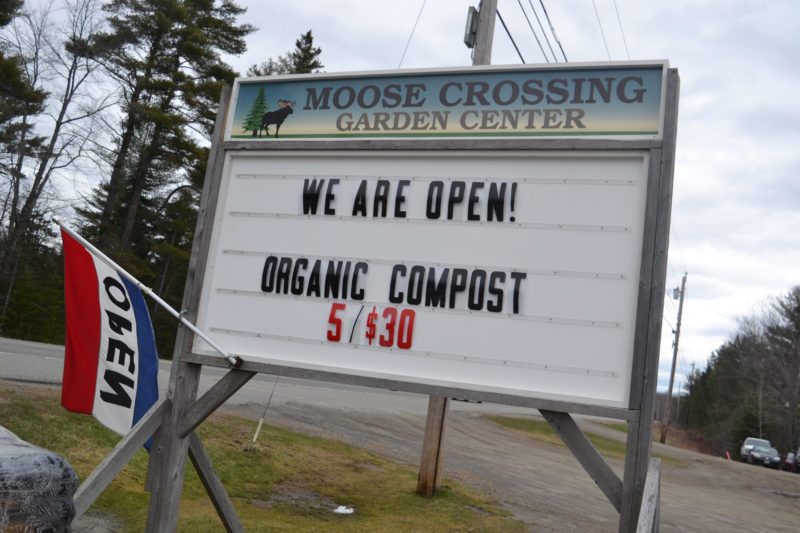How many times have you driven past Moose Crossing Garden Center in Waldoboro and wished you could grow plants as pretty as the ones sold there — and keep them alive and thriving?
Enter Moose Crossing grower and co-owner Tyler Lupien, who offers his expert advice to inexperienced and/or fearful gardeners on what to plant in order to have the greatest chance of being successful.

Moose Crossing Garden Center in Waldoboro is open seven days a week. (Christine LaPado-Breglia photo)
When asked for a brief list of plants for the novice gardener, Lupien said he “tried to pick plants that are quite easy to care for.” He came up with a short-but-sweet list of annuals and perennials.
But first, let’s deal with some basic terminology – the definition of “annuals” versus “perennials.”
Annuals, according to gardenguides.com, are “plants that have just one growing cycle. They are planted in the spring and die in the fall after the first frost.” Marigolds, morning glories, violas, and pansies are examples of annuals.
Perennials, the website offers, “grow and multiply in the garden for three-plus years.” Peonies, hostas, and black-eyed Susans, for instance, are perennials.
For those interested strictly in container gardening, gardenguides.com offers this advice: “For most gardeners, annuals are their choice for their container plantings. However, some gardeners plant perennials in their containers, and then transplant them into their gardens in mid- to late summer so that they will return the following year.”
Here is Lupien’s go-to list:
Annuals:
Pansies:

The popular (and hardy) pansy is an annual that comes in a variety of colors. (Christine LaPado-Breglia photo)
The pansy, according to Lupien, is “one of the few flowering plants you can plant now that will take very cold spring weather. It will take a freeze if properly hardened off, which ours are, as well as snow on top — let’s hope that is over!”
Pansies are available in bright colors and are easy to care for. Lupien notes that they “are traditionally thought of as a spring crop because they tend to slow down flowering in the heat of the summer, but if you site them in a cooler spot or light shade, they can bloom throughout the season.”
“Supertunias”:
“These vigorous hybrid petunias will fill a spot like no other,” says Lupien. Available in a wide range of colors, they are “extremely fast-growing and floriferous. These plants need much less cleaning than traditional bedding petunias. Prune aggressively if needed. Will take some cool temperatures – 30 degrees — but not much more (cold than that).”
Tuberous begonias:
“The lovely blooms on this old-fashioned plant are sure to please,” Lupien offers. “Available in a wide range of cheery colors, these plants are best suited for shade or part shade. Plant after danger of frost.”
Perennials:

Coral bells, which come in a variety of colors, are perennials suitable for shady areas. (Christine LaPado-Breglia photo)
Heuchera:
“Heuchera, or coral bells, are a perennial for shade or part shade that gardeners are finding a wide range of uses for,” says Lupien. “They have a lovely bell-shaped flower that attracts pollinators, but are also used for their wide leaves of colors ranging from chartreuse to orange to burgundy.”
Shasta daisy (Leucanthemum):
Lupien describes the Shasta daisy, a hybrid daisy developed by Luther Burbank in northern California in the 1890s, as a “traditional perennial favorite for late summer color.”
This classic daisy is “great in a sunny or partly sunny location,” he says. “Various heights of white, cream, or yellow flowers are held above glossy green foliage. Many feathery or frilly blossoms are also available.”
Lupien says the Shasta daisy is easy to grow “and a very hardy perennial for the border” of one’s garden.
Moose Crossing Garden Center is located at 3033 Atlantic Highway, Waldoboro. According to its website, moosecrossinggardencenter.com, Moose Crossing “has been growing plants in Midcoast Maine since 1973, founded on the principles of providing high-quality, locally grown products at affordable prices.
“The Lupien family (business) has slowly grown from one small greenhouse to 19 greenhouses covering 80,000 square feet of growing and retail space.”
Moose Crossing Garden Center is open seven days a week from 9 a.m. to 5 p.m.






